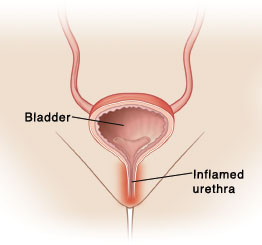Urethritis in Women
We understand that gender is a spectrum. We may use gendered terms to talk about anatomy and health risk. Please use this sheet in a way that works best for you and your provider as you talk about your care.
Urethritis occurs when the urethra is red and swollen (inflamed). The urethra is the tube that passes urine from the bladder to outside the body. The urethra can get swollen and cause burning pain when you urinate. You may also have pain with sex. It can cause pain in the belly (abdomen) or pelvis. A urethral or vaginal discharge may also occur.
 |
| An inflamed urethra can cause pain during urination. |
What causes urethritis?
Urethritis can be caused by a bacterial or viral infection. This kind of infection can lead to conditions such as a urinary tract infection (UTI) or sexually transmitted infection (STI). Urethritis can also be caused by an injury or because of sensitivity or allergy to chemicals in lotions and other products. People who are postmenopausal are at risk for urethritis.
How is urethritis diagnosed?
Your healthcare provider will examine you and ask about your symptoms and health history. You may also have one or more of the following tests:
-
Urine test. Urine samples are taken and checked for problems.
-
Blood test. A blood sample is taken and checked for problems.
-
Vaginal culture. A sample of vaginal discharge is taken and tested for problems. A cotton swab is inserted into the vagina.
-
Cystoscopy. This test lets the provider look for problems in the urinary tract. The test uses a thin, flexible telescope called a cystoscope with a light and camera attached. The scope is put into the urethra.
-
Ultrasound. This lets the healthcare provider see a detailed image of the inside of your pelvis. Ultrasound will not show if you have urethritis. But it may show other signs of STIs that can also cause urethritis.
-
Nucleic acid test (NAT). This can tell if you have a virus or bacteria. It may be done instead of a culture because it allows for a faster diagnosis.
How is urethritis treated?
Treatment depends on the cause of urethritis. If it’s due to a bacterial infection, medicines that fight infection (antibiotics) will be given. Your healthcare provider can tell you more about your treatment options. In the meantime, your symptoms can be treated. To relieve pain and swelling, anti-inflammatory medicines, such as ibuprofen, may be given. Untreated, symptoms may get worse. It can also cause scar tissue to form in the urethra, making it narrow. And it can lead to pelvic inflammatory disease.
When to call your healthcare provider
Call the healthcare provider right away if you have any of the following:
-
Fever of 100.4° F ( 38.0°C ) or higher, or as directed by your provider
-
Burning pain with urination
-
Belly or pelvic pain
-
Increased urge to urinate
-
Discharge from the vagina
Preventing STIs
When it comes to sex, it’s important to take care and be safe. Any sexual contact with the penis, vagina, anus, or mouth can spread an STI. The only sure way to prevent STIs is not to have sex (abstinence). But there are ways to make sex safer. Use a latex condom each time you have sex. And talk with your partner about STIs before you have sex.